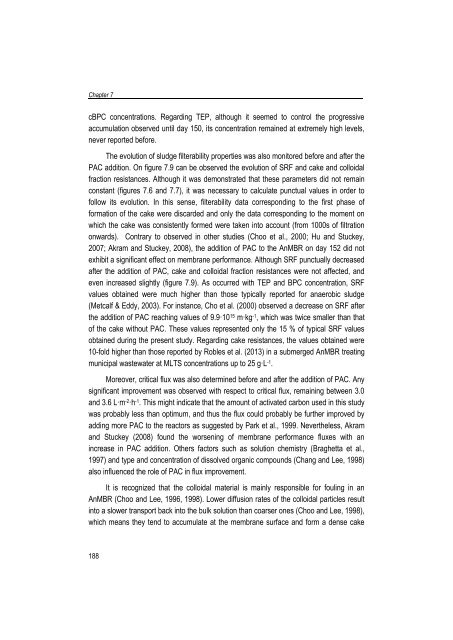Combining submerged membrane technology with anaerobic and ...
Combining submerged membrane technology with anaerobic and ...
Combining submerged membrane technology with anaerobic and ...
You also want an ePaper? Increase the reach of your titles
YUMPU automatically turns print PDFs into web optimized ePapers that Google loves.
Chapter 7cBPC concentrations. Regarding TEP, although it seemed to control the progressiveaccumulation observed until day 150, its concentration remained at extremely high levels,never reported before.The evolution of sludge filterability properties was also monitored before <strong>and</strong> after thePAC addition. On figure 7.9 can be observed the evolution of SRF <strong>and</strong> cake <strong>and</strong> colloidalfraction resistances. Although it was demonstrated that these parameters did not remainconstant (figures 7.6 <strong>and</strong> 7.7), it was necessary to calculate punctual values in order tofollow its evolution. In this sense, filterability data corresponding to the first phase offormation of the cake were discarded <strong>and</strong> only the data corresponding to the moment onwhich the cake was consistently formed were taken into account (from 1000s of filtrationonwards). Contrary to observed in other studies (Choo et al., 2000; Hu <strong>and</strong> Stuckey,2007; Akram <strong>and</strong> Stuckey, 2008), the addition of PAC to the AnMBR on day 152 did notexhibit a significant effect on <strong>membrane</strong> performance. Although SRF punctually decreasedafter the addition of PAC, cake <strong>and</strong> colloidal fraction resistances were not affected, <strong>and</strong>even increased slightly (figure 7.9). As occurred <strong>with</strong> TEP <strong>and</strong> BPC concentration, SRFvalues obtained were much higher than those typically reported for <strong>anaerobic</strong> sludge(Metcalf & Eddy, 2003). For instance, Cho et al. (2000) observed a decrease on SRF afterthe addition of PAC reaching values of 9.9·10 15 m·kg -1 , which was twice smaller than thatof the cake <strong>with</strong>out PAC. These values represented only the 15 % of typical SRF valuesobtained during the present study. Regarding cake resistances, the values obtained were10-fold higher than those reported by Robles et al. (2013) in a <strong>submerged</strong> AnMBR treatingmunicipal wastewater at MLTS concentrations up to 25 g·L -1 .Moreover, critical flux was also determined before <strong>and</strong> after the addition of PAC. Anysignificant improvement was observed <strong>with</strong> respect to critical flux, remaining between 3.0<strong>and</strong> 3.6 L·m -2·h -1 . This might indicate that the amount of activated carbon used in this studywas probably less than optimum, <strong>and</strong> thus the flux could probably be further improved byadding more PAC to the reactors as suggested by Park et al., 1999. Nevertheless, Akram<strong>and</strong> Stuckey (2008) found the worsening of <strong>membrane</strong> performance fluxes <strong>with</strong> anincrease in PAC addition. Others factors such as solution chemistry (Braghetta et al.,1997) <strong>and</strong> type <strong>and</strong> concentration of dissolved organic compounds (Chang <strong>and</strong> Lee, 1998)also influenced the role of PAC in flux improvement.It is recognized that the colloidal material is mainly responsible for fouling in anAnMBR (Choo <strong>and</strong> Lee, 1996, 1998). Lower diffusion rates of the colloidal particles resultinto a slower transport back into the bulk solution than coarser ones (Choo <strong>and</strong> Lee, 1998),which means they tend to accumulate at the <strong>membrane</strong> surface <strong>and</strong> form a dense cake188
















